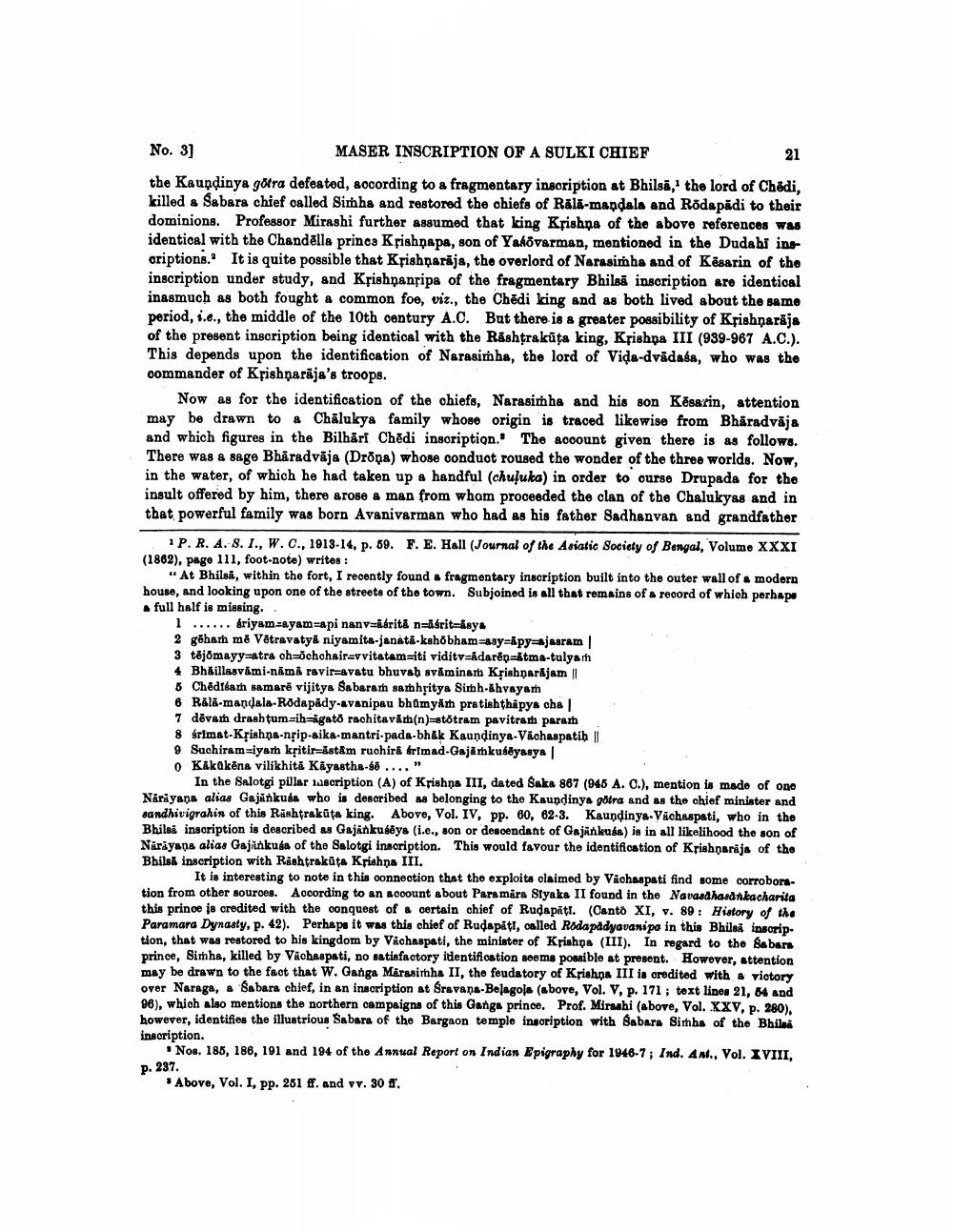________________
No. 3] MASER INSCRIPTION OF A SULKI CHIEF
21 the Kauņdinya götra defeated, according to a fragmentary inscription at Bhilsa," the lord of Chēdi, killed a Sabara chief called Simha and restored the chiefs of Rälä-mandala and Rödspädi to their dominions. Professor Mirashi further assumed that king Krishna of the above references was identical with the Chandella princa Krishnapa, son of Yahovarman, mentioned in the Dudabi in criptions. It is quite possible that Krishnaraja, the overlord of Narasimha and of Kësarin of the inscription under study, and Krishnansipa of the fragmentary Bhilsa inscription are identical inasmuch as both fought a common foe, viz., the Chēdi king and as both lived about the samo period, i.e., the middle of the 10th century A.C. But there is a greater possibility of Kţishnarāja of the present inscription being identical with the Rashtrakūta king, Krishna III (939-967 A.C.). This depends upon the identification of Narasimha, the lord of Vida-dvadasa, who was tho commander of Krishnarāja's troops.
Now as for the identification of the chiefs, Narasimha and his son Kēsarin, attention may be drawn to & Chālukya family whose origin is traced likewise from Bhäradvāja and which figures in the Bilhări Chēdi inscription. The account given there is as follows. There was & sage Bhāradvāja (Drona) whose conduct roused the wonder of the three worlds. Now, in the water, of which he had taken up a handful (chuluka) in order to curse Drupada for the insult offered by him, there arose a man from whom proceeded the clan of the Chalukyas and in that powerful family was born Avaniverman who had as his father Sadhanvan and grandfather
1 P. R. A. 8. I., W. C., 1913-14, p. 69. F. E. Hall (Journal of the Asiatic Society of Bengal, Volume XXXI (1862), page 111, foot-noto) writes :
"At Bhilsa, within the fort, I recently found a fragmentary inscription built into the outer wall of a modern house, and looking upon one of the streets of the town. Subjoined is all that remains of a record of which perhapo full half is missing..
1 ... ... &riyam-ayam-api nanvidrita n=&srit-sys 2 g ham mo Vetravaty. niyamite-janata-kshobhamasy=&py-ajaaram 3 tējomayy=stra chochchairsvvitatam=iti vidity=Adarêp=itma-tulyar 4 Bhaillasvämi-namá ravir-svatu bhuvab sviminar Krishnarajam | 8 Chēdisarh samarë vijitya Sabaram sambhitys Simh-ahvayam B Rali-mandala-Rodapădy-avanipau bhůmym pratishthipya cha 7 dēvam drashtum=ih=gató rachitavām(n)=stötram pavitrah param 8 srimat-Krishna-nrip-aika-mantri-pada-bhák Kaundinya.Vkohaspatih | 9 Suchiramniyam kļitir-&stām ruchira brimad.Gajankutyanya
Kakakēna vilikhitā Kāyastha-so ...."
In the Salotgi püller 1scription (A) of Krishna III, dated Saka 867 (946 A. O.), mention is made of one Nárayana alias Gajankusa who is described as belonging to the Kaundinya götra and as the chief minister and sandhirigrahin of this Rashtrakūta king. Above, Vol. IV, pp. 60, 62-3. Kaundinya-Vichaspati, who in the Bhils: inscription is described as Gajankusäys (i.e., son or descendant of Gajankusa) is in all likelihood the son of Nariyana alias Gajinkusa of the Salotgi inscription. This would favour the identification of Krishnaraja of the Bhilsa inscription with Rashtrakūta Krishna III.
It is interesting to note in this connection that the exploits claimed by Vächsspati find some corroboretion from other sources. According to an account about Para mára Styaka II found in the Navaadhasankacharita this prince is credited with the conquest of a certain chief of Rudapati. (Canto XI, v. 89: History of the Paramara Dynasty, p. 42). Perhaps it was this chief of Rudapáti, called Roda padyavanipa in this Bhilsa inscription, that was restored to his kingdom by Vichaspati, the minister of Krishna (III). In regard to the saben prince, Simha, killed by Váchaspati, no satisfactory identification seems possible at present. However, attention may be drawn to the fact that W. Ganga Marasimha II, the feudatory of Krishna III is credited with a victory over Naraga, a Sabara chief, in an inscription at Sravana-Belagola (above, Vol. V, p. 171 ; toxt lines 21, 54 and 96), which also mentions the northern campaigns of this Ganga prince. Prof. Mirashi (above, Vol. XXV, p. 280), however, identifies the illustrious Sabara of the Bargaon temple inscription with Babara Simha of the Bhilma inscription.
Nos. 185, 186, 191 and 194 of the Annual Report on Indian Epigraphy for 1948-7; Ind. An., Vol. XVIII, p. 237.
Above, Vol. I, pp. 281 f. and vv. 30 fr.




